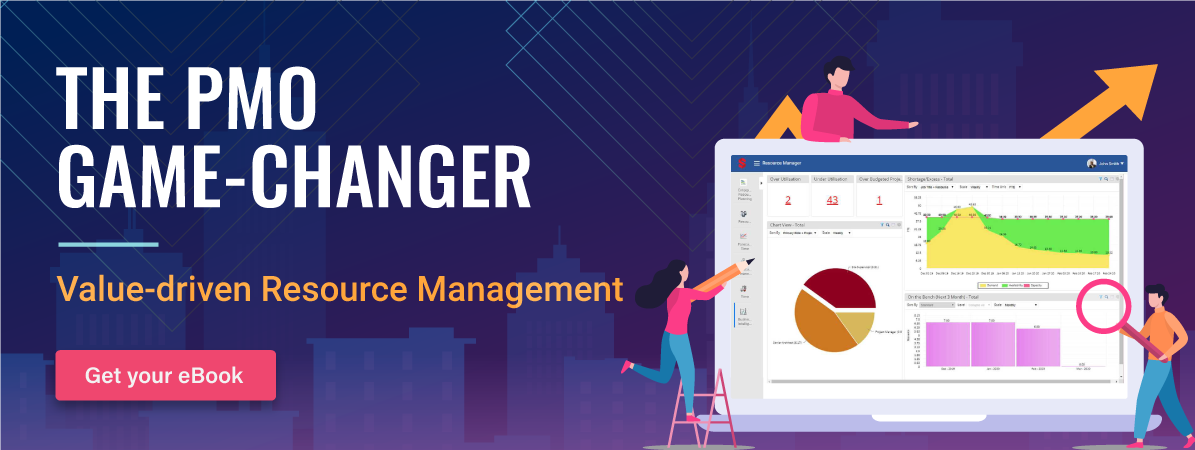No project is risk-proof, and IT projects are no exception. There are various risks in IT projects from clients frequently changing their requirements to overshooting budgets and deadlines.
According to the 2020 PMI report,
“17% of IT projects fail due to numerous risks.”
Thus, the necessity for risk management has become unavoidable in the IT projects sector. This blog will explain the various risks that aggravate the IT projects and also provide ways to eliminate those threats.
But first, let’s start with the definition.
What is IT Project Management?
An IT project typically deals with IT infrastructure, information systems, or computer technology. Some of the most common IT projects are web development, software development, mobile app development, network configuration, hardware installation, etc.
As the name suggests, IT project management involves taking control of such projects from initiation to closure. It includes planning, scheduling, design, development, and reporting.
What are IT Project Risks?
Like every other project, IT projects are also prone to various risks. Here is a rundown of the most common risks that can plague IT project management:
Scope creep
Scope creeps are inevitable, and almost every project suffers from scope creeps at a particular stage. Furthermore, the probability of scope creep increases depending on the size and complexity of the project.
These are mainly caused due to changing requirements of stakeholders or clients. However, sometimes internal miscommunication also leads to scope changes.
Such changes result in wasted productivity, key deliverables getting missed out, project overruns, and so on. Ultimately, the whole project can look very different from what was initially envisioned. For example, the luggage handling system project of the Denver International Airport failed due to overwhelming scope changes.
Unclear requirements
There may be situations where the client wants something particular, but the project team has misconstrued the requirements and is working on something completely different. This lack of clarification mainly occurs due to poor communication from clients and stakeholders. This situation escalates, even more when stakeholders are not kept in the loop.
Unclear requirements may lead to unfinished tasks, a complete or partial change of the deliverable, schedule changes, extra resources, etc. For example, the Chrysler Comprehensive Compensation System project was shut down due to a lack of clarity regarding business requirements.
Budget overrun
Similar to scope creep, budget overruns also have an adverse effect on IT projects. They are more or less related to one another. For instance, changing the scope of a project causes budget overruns. Other factors include inaccurate budget estimation at the initial stage, allocating high-cost local resources, etc.
McKinsey and the University of Oxford conducted joint research on 5400 IT projects. According to their report, all these IT projects had a total overrun of $66 billion, and 66% of those projects had cost overruns.
Time overrun
Time overrun is another common IT project risk. It generally occurs due to scope changes, poorly estimated tasks, unplanned resource absences, poor communication with the client, etc.
For example, let’s consider that a highly experienced resource is allocated to a critical task and plays a vital role in task completion. But due to some reason, they remain absent, delaying the critical task and its dependencies. Subsequently, the project fails to deliver on time.
Employee turnover
Unplanned employee attrition is a significant concern for all IT project managers. The main reason behind this is the excessive workload on the resources. But there may be other reasons such as lack of employee recognition, insufficient opportunities for career development, vague understanding of role and responsibilities, etc.
For instance, assigning a critical task to a new hire will be overwhelming. As a result, the resource will need training, which will, in turn, increase the timeline. Besides, overburdened with the work pressure, the resource will be demoralized, and it will hamper their productivity. Consequently, the resource may leave the company.
Resolving conflicts
Since project managers need to manage various resources within a project, internal conflicts are inevitable. One of the most project conflicts is the general ambiguity regarding roles and responsibilities. Often, project managers tend to assume that resources know what is expected of them. Likewise, they suppose that team members are aware of their duties towards the project. But that is not always true.
Role conflicts can lead to a lack of trust, poor team collaboration, compromised project quality, client dissatisfaction, etc.
Gold plating
Gold plating means adding extra features that were not part of the initial project scope. There are various reasons behind gold plating, such as proving ability, earning extra credit, hiding defects, etc. However, although done with good intentions to impress the client, gold plating may not be fruitful in practicality as it overshoots the budget and timeline in the process.
Moreover, as you enhance the product with additional features without the client’s approval, it accounts for unauthorized changes in the scope. As a result, they may refuse to accept the deliverable.
Unprecedented surprises
Apart from the risks mentioned above, IT projects may be subject to sudden surprises. For instance, the Covid-19 pandemic that wreaked havoc across the globe mandated remote work across projects. Accordingly, people were forced to stay inside their homes. Besides, offices had to be shut down, schools had to be closed, and so on. Project-centric organizations were not able to deliver projects as employees could not collaborate.
As a result, decision-makers had to either halt or even cancel the projects. As per Dodge Data and analytics,
“In April 2020, 40% of construction projects were delayed due to the pandemic.”
Lost opportunity due to skill shortages
Resource shortage is a significant issue that haunts IT, project managers. It occurs when resource demand exceeds the number of available resources.
One of the main reasons behind resource scarcity is the lack of visibility into future resource capacity. For instance, let’s assume that there is a pipeline project which requires highly skilled resources. But due to a lack of forecasting, you cannot view the future availability of resources. As a result, you have to hire new resources. However, that will incur more costs, and the stakeholders don’t approve of that. Thus, finally, it leads to a lost market opportunity.
Technology risks
Technological risks occur when an implementation does not work as anticipated. These risks may lead to security breaches, system failures, increased maintenance time, etc.
Even with the most comprehensive technical documentation and the best training models and algorithms in place, components can still misfire and generate errors.
Ways to Mitigate these Risks
One can avoid all the risks mentioned above with the help of these practices. These are:
Develop an effective project plan
A project plan helps in determining the goals and objectives of the project. Moreover, with the WBS in place, one can clear out the tasks, subtasks, deliverables, and interdependencies. Thus, the project manager can create an effective project schedule and allocate resources as per the plan.
Communicate regularly with clients
Constant communication with the client and the stakeholders helps clarify all the aspects of the project. Moreover, it keeps the project manager updated with stakeholders’ requirements to avoid hiccups during the project course. Besides, keeping the client in the loop during each stage ascertains that everything is going as planned.
Monitor project financials
Project managers must periodically track and compare the actual spending against the estimated budget. Tracking project financials throughout the project helps avoid cost overruns. A resource management solution helps monitor critical project financials such as costs, revenue, profit margins, and overheads. If there is a variance, then one can apply corrective measures to mitigate the financial risks.
Ensure timely completion of critical tasks
Critical tasks define the schedule of the whole project. Therefore, if a crucial task gets delayed, it will elongate the project schedule. Thus, to ensure that critical tasks are completed within the stipulated time, you must assign experienced resources. Moreover, you must keep track of the progress of such tasks. Thus, if any discrepancy occurs, then you can take proactive measures.
Ensure optimum allocation and effective utilization
Sub-optimal resource allocation and utilization are the major causes behind resource attrition. And to avoid that, you must deploy resources based on their skills, capacity, and availability. Moreover, once allocated, you must monitor their utilization rates and enhance productivity by mobilizing them from non-billable to billable work. Additionally, resourcing techniques such as resource leveling and smoothing to ensure that they are optimally utilized.
Document every important activity
As a project manager, you must make sure that there is no confusion between the team members. Confusions lead to conflicts, and that can make the project go haywire. Thus, to eliminate any unnecessary conflict, you should document every activity from the get-go and pass it on to all the members. That way, everyone is on the same page.
Stringent review of the project scope
To avoid gold-plating of any sort, you must monitor the scope baseline. That way, you can see if any unnecessary change is made to the deliverable. Moreover, you should control the communication and review every change request. If any change is required, you must first get it approved by the client and the stakeholders. Only then can you implement the changes.
Have a backup plan
Even if you have a full-proof risk mitigation plan, you should always have a contingency plan if something goes wrong. For instance, you must have a pool of specific resources on reserve if a project team member leaves in the middle of the project. But, you must also keep those reserve resources in the loop. That way, you can avoid further training when they are needed.
Resource forecasting and capacity planning
Forecasting resources can help avoid resource shortages for pipeline projects. With a resource management tool, you can track the current utilization rate of resources and ascertain their future availability. It will give you the leeway to bridge the capacity gap if there is a shortage. You can hire new resources or train existing resources, thus, eliminating the chances of last-minute firefighting.
Gap analysis to find a quick solution
A gap analysis helps clarify three key elements- the current situation, the ideal situation, and what should be done to minimize the gap. In addition, it helps identify particular areas for improvement and provides guidance towards actionable steps for improving the product.
IT Risk Management Framework
It’s better to have a risk management framework that can help minimize the impact of the risks. The following is a detailed description of a streamlined risk management framework:
Risk Identification
Having proper knowledge about the potential risks that can occur anytime during the project lifecycle helps to brace and deal with them better. Therefore, the first step is to identify the threat. For that, you can brainstorm with the project members and determine the risk. Based on that, you may create a risk register.
Risk Analysis
In this step, you will have to determine the impact of the risks. Furthermore, you may categorize the risks into core or non-core risks. Core risks need to be mitigated immediately as they can hamper project growth or team productivity. Non-core risks can be attended to eventually.
Risk Assessment
Once risk identification and analysis are made, the next step is assessing the nature and effect of the risks. There are two types of threats- positive risks and negative risks. Positive risks can be implemented in the project, whereas negative risks have to be mitigated.
Risk Treatment
It is the most crucial step in the whole framework. After measuring the type and impact of the risk, you will have to come up with a plan to eliminate the adverse risk. For instance, you may develop a contingency plan or discuss it with the stakeholders or the team members.
Risk Monitoring
It is essential to monitor the aggregate risk measures to ensure that risk levels remain optimal. For that, you may have to collaborate with the people who are managing the risks. Thus, it is necessary to have a transparent communication strategy.
Conclusion
There is no IT project without risks. As a project manager, you have to pay attention to every detail and monitor the project’s progress. In a nutshell, you must have an effective risk management strategy, as mentioned above. That way, you can eliminate the risks and ensure successful project delivery.
SAVIOM Solution
SAVIOM has over 20 years of experience helping multinational clients manage their resources efficiently and effectively. With over 20 years of experience, this Australian-based MNC has a global presence across 50 countries and has helped 100+ clients meet their specific business goals. Saviom also provides tools for project portfolio management, professional service automation, and workforce planning software. So, SAVIOM can help your business to establish an efficient system geared towards your specific business challenges.



















